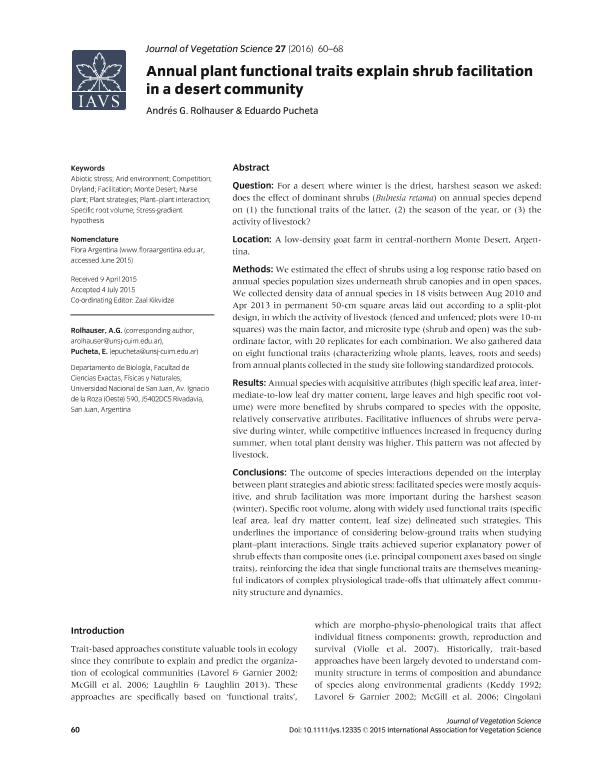Mostrar el registro sencillo del ítem
dc.contributor.author
Rolhauser, Andrés Guillermo

dc.contributor.author
Pucheta, Eduardo Raúl

dc.date.available
2018-07-06T17:01:38Z
dc.date.issued
2016-01
dc.identifier.citation
Rolhauser, Andrés Guillermo; Pucheta, Eduardo Raúl; Annual plant functional traits explain shrub facilitation in a desert community; Wiley Blackwell Publishing, Inc; Journal of Vegetation Science; 27; 1; 1-2016; 60-68
dc.identifier.issn
1100-9233
dc.identifier.uri
http://hdl.handle.net/11336/51520
dc.description.abstract
Question: For a desert where winter is the driest, harshest season we asked: does the effect of dominant shrubs (Bulnesia retama) on annual species depend on (1) the functional traits of the latter, (2) the season of the year, or (3) the activity of livestock? Location: A low-density goat farm in central-northern Monte Desert, Argentina. Methods: We estimated the effect of shrubs using a log response ratio based on annual species population sizes underneath shrub canopies and in open spaces. We collected density data of annual species in 18 visits between Aug 2010 and Apr 2013 in permanent 50-cm square areas laid out according to a split-plot design, in which the activity of livestock (fenced and unfenced; plots were 10-m squares) was the main factor, and microsite type (shrub and open) was the subordinate factor, with 20 replicates for each combination. We also gathered data on eight functional traits (characterizing whole plants, leaves, roots and seeds) from annual plants collected in the study site following standardized protocols. Results: Annual species with acquisitive attributes (high specific leaf area, intermediate-to-low leaf dry matter content, large leaves and high specific root volume) were more benefited by shrubs compared to species with the opposite, relatively conservative attributes. Facilitative influences of shrubs were pervasive during winter, while competitive influences increased in frequency during summer, when total plant density was higher. This pattern was not affected by livestock. Conclusions: The outcome of species interactions depended on the interplay between plant strategies and abiotic stress: facilitated species were mostly acquisitive, and shrub facilitation was more important during the harshest season (winter). Specific root volume, along with widely used functional traits (specific leaf area, leaf dry matter content, leaf size) delineated such strategies. This underlines the importance of considering below-ground traits when studying plant-plant interactions. Single traits achieved superior explanatory power of shrub effects than composite ones (i.e. principal component axes based on single traits), reinforcing the idea that single functional traits are themselves meaningful indicators of complex physiological trade-offs that ultimately affect community structure and dynamics. Whether functional traits determine species' abundance within a given community remains unresolved. We show that ecological strategies of desert annuals determined their abundance in relation to dominant shrubs: acquisitive species were facilitated, whereas conservative ones were repelled. Specific root volume, along with widely used functional traits (specific leaf area, leaf dry matter content, and leaf size) delineated such annual-plant strategies.
dc.format
application/pdf
dc.language.iso
eng
dc.publisher
Wiley Blackwell Publishing, Inc

dc.rights
info:eu-repo/semantics/openAccess
dc.rights.uri
https://creativecommons.org/licenses/by-nc-sa/2.5/ar/
dc.subject
Abiotic Stress
dc.subject
Arid Environment
dc.subject
Competition
dc.subject
Dryland
dc.subject
Facilitation
dc.subject
Monte Desert
dc.subject
Nurse Plant
dc.subject
Plant Strategies
dc.subject
Plant-Plant Interaction
dc.subject
Specific Root Volume
dc.subject
Stress-Gradient Hypothesis
dc.subject.classification
Otras Ciencias Biológicas

dc.subject.classification
Ciencias Biológicas

dc.subject.classification
CIENCIAS NATURALES Y EXACTAS

dc.title
Annual plant functional traits explain shrub facilitation in a desert community
dc.type
info:eu-repo/semantics/article
dc.type
info:ar-repo/semantics/artículo
dc.type
info:eu-repo/semantics/publishedVersion
dc.date.updated
2018-06-22T14:39:30Z
dc.journal.volume
27
dc.journal.number
1
dc.journal.pagination
60-68
dc.journal.pais
Reino Unido

dc.journal.ciudad
Londres
dc.description.fil
Fil: Rolhauser, Andrés Guillermo. Consejo Nacional de Investigaciones Científicas y Técnicas. Oficina de Coordinación Administrativa Parque Centenario. Instituto de Investigaciones Fisiológicas y Ecológicas Vinculadas a la Agricultura. Universidad de Buenos Aires. Facultad de Agronomía. ; Argentina. Universidad Nacional de San Juan. Facultad de Ciencias Exactas, Físicas y Naturales. Departamento de Biología; Argentina
dc.description.fil
Fil: Pucheta, Eduardo Raúl. Consejo Nacional de Investigaciones Científicas y Técnicas; Argentina. Universidad Nacional de San Juan. Facultad de Ciencias Exactas, Físicas y Naturales. Departamento de Biología; Argentina
dc.journal.title
Journal of Vegetation Science

dc.relation.alternativeid
info:eu-repo/semantics/altIdentifier/doi/http://dx.doi.org/10.1111/jvs.12335
dc.relation.alternativeid
info:eu-repo/semantics/altIdentifier/url/https://onlinelibrary.wiley.com/doi/abs/10.1111/jvs.12335
Archivos asociados
